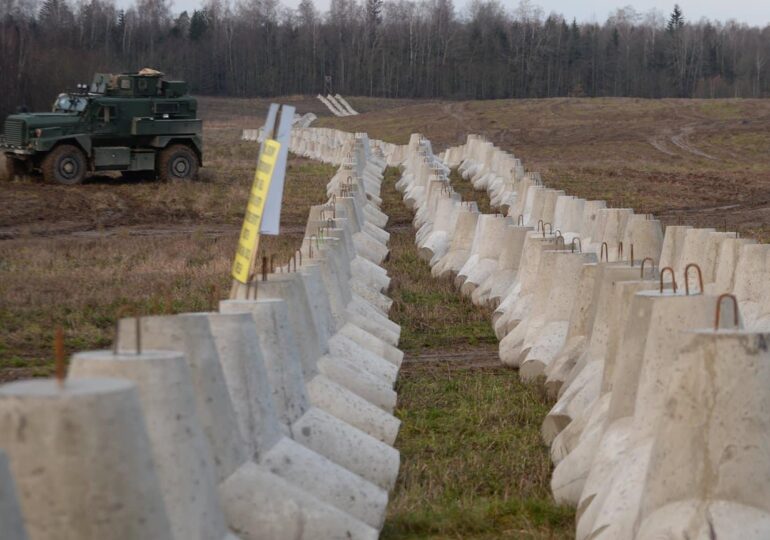In 1946, Winston Churchill announced that an „iron curtain” had descended over Europe „from Stettin, in the Baltic, to Trieste, in the Adriatic.” Now, a new „curtain” separates Europe from Russia.
Every European nation bordering Russia and its ally Belarus is accelerating plans to build hundreds of kilometers of fortified granite to defend against a possible Russian aggression.
The reasons are clear. The post-war European security framework – based on strengthening institutions and international trade, expanding NATO, and American military guarantees – is eroded, writes The Conversation. The publication analyzes efforts to secure borders with Russia in northern and eastern Europe.
Finns Get to Work
With a 1,336-kilometer border with Russia, Finland proposed in 2023 the construction of a wall covering about 15% of its frontier, costing over $400 million, with hopes of completion by 2026.
Partially motivated by Russia's invasion of Ukraine in 2022, but also by the increasing number of Russian citizens fleeing to Finland to avoid conscription, the Finnish government in July 2023 passed a law to build taller and more resilient fences, as the wooden ones were designed only to prevent animal crossings. Eight border posts were erected (including north of the Arctic Circle) alongside larger barriers in the country's southernmost strip.
Even defense systems are being raised in remote areas of northeastern Finland, where not too long ago, constant streams of Russians and Finns were crossing the border to buy groceries.
What Estonia, Latvia, Lithuania, and Poland Are Doing
Finland isn't the first European state taking such measures. In August 2015, Estonia announced it would build a fence along its eastern border with Russia following Moscow's annexation of Crimea in 2014.
In 2024, the Baltic states and Poland proposed further fortifying their borders with a defensive wall. It would cover 700 kilometers and cost over 2.3 billion euros. Plans and construction are now accelerated as Baltic leaders fear that prospects of a truce between Ukraine and Russia could mean Moscow directing its military force towards them.
Latvia will invest about $350 million in the coming years to strengthen its 384-kilometer border with Russia, while Lithuania plans a 50-kilometer defense line against a possible Russian invasion.
Poland has begun constructing a permanent fence on its border with Belarus as part of its defense against potential Moscow allies.
These defensive walls will be accompanied by other physical barriers such as anti-tank ditches, 15-ton concrete dragon's teeth (to halt Russian tank advances), massive concrete blocks and pyramids, road barriers, massive metal gates, minefields, and blocked bridgeheads.
Lithuania plans up to 48 kilometers of trenches, bridges prepared to be bombed in case of invasion, and trees ready to fall on roads if needed.
The Baltic states are also building over 1,000 bunkers, ammunition depots, and supply shelters to further protect the 965 kilometers of territory bordering Russia. The bunkers are expected to have an area of around 35 square meters, accommodate up to ten soldiers, and withstand Russian artillery attacks.
The Baltic nations, plus Finland and Poland, also announced this year that they are withdrawing from the 1997 international treaty banning anti-personnel landmines, while Lithuania revoked its commitment to a cluster munitions treaty.
Poland announced in June 2025 that it added minefields to its "Eastern Shield" border plans.
A "Drone Wall" Is Rising
These border defense systems will use the latest technologies, early warning systems, and artillery units. Lithuania, Latvia, Estonia, Poland, Finland, and Norway met in Riga in 2024 to begin plans for constructing a 2,900-kilometer "drone wall" to protect their borders.
This wall will have a sensor network, composed of radars and electronic warfare tools to identify and destroy Russian drones. Within seconds of detecting a target crossing the border, there will be a careful drone recognition system.
This project will require close cooperation among participating states. Estonian companies are already designing drones that can detect and neutralize threats along the complex terrains of lakes, swamps, and forests covering Russia's border with the Baltic countries.
Historical Lessons
Both cooperation among all countries bordering Russia in Europe and understanding the terrain are essential to avoid failures like the Maginot Line, part of a set of defensive barriers France built along its borders in the '30s that failed to prevent a German invasion in World War II.
It was assumed then that Germans couldn't pass through the Ardennes forest in Belgium. Although the Maginot fortifications forced Germans to rethink their attack plan, Belgium remained vulnerable.
Today, European nations are aware they cannot fully prevent a Russian attack, but can shape the nature of a Russian invasion. The purpose of these barriers is both deterrence and an attempt to control the point of an invasion.
If a truce is announced between Ukraine and Russia, Baltic nation leaders fear Moscow could redeploy troops to their borders. Neighboring countries with Russia have learned from past and present lessons and are now striving to be as prepared as possible for whatever Vladimir Putin may do next.

